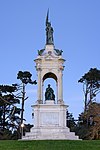Statue of Junípero Serra (San Francisco)

A 30-foot (9.1 m) tall statue of Junípero Serra was installed in San Francisco's Golden Gate Park, in the U.S. state of California. It had first been erected in 1907 and sculpted by Douglas Tilden. The memorial was toppled on June 19, 2020, during the George Floyd protests, as a Juneteenth commemoration. The next day another memorial for Serra was torn down in Los Angeles at Father Serra Park by about five dozen indigenous activists. Other statues of Junípero Serra were involved as the protests expanded to include monuments of individuals associated with the controversy over the genocide of indigenous peoples in the Americas. Demonstrators also toppled or otherwise vandalized the statues of Francis Scott Key (author of the lyrics to The Star-Spangled Banner), Ulysses S. Grant, and a group consisting of Don Quixote and his companion, Sancho Panza kneeling to honor their creator, Cervantes.Serra, as a major part of the California mission development by Spain in the 18th century, attempted to convert Native Californians to Catholicism. Serra's reputation and missionary work have been condemned by critics, who cite alleged mandatory conversions to Catholicism, followed by abuse of the Native American converts.
Excerpt from the Wikipedia article Statue of Junípero Serra (San Francisco) (License: CC BY-SA 3.0, Authors, Images).Statue of Junípero Serra (San Francisco)
Bowl Drive, San Francisco
Geographical coordinates (GPS) Address External links Nearby Places Show on map
Geographical coordinates (GPS)
| Latitude | Longitude |
|---|---|
| N 37.77183 ° | E -122.46657 ° |
Address
Padre Junipero Serra
Bowl Drive
94122 San Francisco
California, United States
Open on Google Maps











